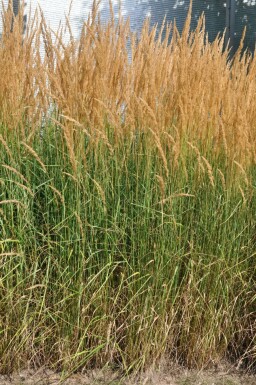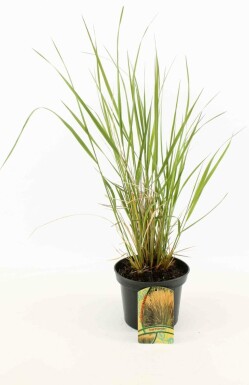





Updated on 10 September 2025
We regret to inform you that we are currently unable to ship orders to the United Kingdom. We anticipate being able to resume shipments at the beginning of 2026.
Calamagrostis offers stunning vertical lines in any garden, making it perfect for borders and modern designs. This hardy, low-maintenance grass thrives in wet or dry conditions, providing year-round beauty and support for birds and insects.
Calamagrostis brings a touch of elegance to any garden with its upright ornamental presence. Known for its narrow flower spikes, this grass showcases colours from silver to gold, adding a dynamic appearance through summer and autumn. Whether in a prairie garden or forming part of a modern landscape, its airy structure makes it a sought-after choice for architectural planting. The feather reed grass not only adds vertical interest but also offers a low-maintenance solution. Considering an addition to garden borders? Explore the graceful options offered by Calamagrostis grass. For those looking to enhance garden aesthetics with ease, this grass offers winter appeal and enduring structure. Interested in transforming your garden? Buy Calamagrostis UK to experience its unique charm.
Calamagrostis, often known as feather reed grass, is a versatile and attractive choice for many gardens. This upright grass is prized for its tall, slender form, creating an architectural presence. Designers love using it in borders, group plantings, and as a specimen plant. Its strong upright structure benefits any landscape, providing seed plumes that sway gently in the wind. Feather reed grass is part of the Poaceae family, and it comes from regions in Europe, Asia, and North America. This global presence shows its adaptability to various climates. It plays an essential role in natural habitats, stabilising riverbanks and offering seeds for birds. The name Calamagrostis is derived from Greek, meaning 'reed grass', symbolising elegance and resilience. It is often seen in zen and prairie gardens. This perennial is drought-resistant and presents good winter interest with its structure, regrowing quickly in spring. Feather reed grass, or vertical ornamental grass, is perfect for a low-maintenance garden. Consider it for waterside planting or as a windbreak. To bring this beauty to your garden, you might look for options to buy Calamagrostis in the UK.
The Calamagrostis is a tall perennial that also functions as an ornamental grass. It presents a striking presence with its clump-forming upright growth. This grass can reach heights ranging from 50 cm to 1.8 m, depending on the specific type and growing conditions. Its elegant form makes it suitable for borders, group planting, and as a specimen plant. The grass is notable for its resilience, being drought-resistant and offering good winter interest due to its enduring structure. Calamagrostis begins to show its charms from June to October. The flowering spikes start as a purplish hue, transitioning to a straw yellow as they mature. Climate, sunlight, care, and soil conditions can influence the exact timing and colour. This ornamental grass is easy to manage, making it ideal for low-maintenance gardens. The feather reed grass is known for its airy and feathery seed plumes, adding to its ornamental appeal. It thrives in various conditions, offering diverse applications like waterside planting or serving as a windbreak. This grass's upright structure benefits not only enhance its aesthetic but also provide a stable presence in any garden setting, particularly in winter when it stands out against the bare landscape.
Calamagrostis has linear, narrow leaves that can be upright or gracefully arching. The leaves are light green to grey-green and turn straw-yellow in autumn, adding visual interest to the garden. These ornamental grasses are winter-hardy and can withstand wind and rain, making them a great choice for UK gardens. Calamagrostis is not evergreen; it loses its leaves in winter, although its upright structure remains, providing winter interest. It thrives in various climates and locations, though it prefers a sunny spot to fully develop its characteristic plumes.
Calamagrostis is very hardy, suitable for USDA zones 3 to 5, and can tolerate temperatures as low as -40°C. Factors such as wind, soil conditions, and the duration of frost impact its winter resilience. This grass is also heat and drought tolerant, thanks to its deep root system and leaf structure, which help retain moisture. Originating from temperate regions, it has adapted to withstand dry conditions and occasional heat waves.
Calamagrostis is safe for gardens as it is not toxic to children or pets, making it a secure choice for family gardens. It contributes positively to biodiversity, attracting birds and insects with its long-lasting plumes and providing a natural habitat. With proper care, such as occasional division and cutting back in late winter or early spring, Calamagrostis can enhance the garden's resilience and beauty year-round.
Calamagrostis is a stunning choice for creating structure and interest in a garden. Its tall, feathery plumes and narrow leaves make it an elegant addition to various garden styles.
Calamagrostis can be beautifully combined with various plants to create stunning garden displays. This ornamental grass adds movement to the garden and is a valuable addition among graceful garden plants. Pairing it in the garden with Echinacea and Rudbeckia provides a contrast of colours and textures. The bright blooms of Echinacea alongside the structural form of Calamagrostis make for an eye-catching display. Meanwhile, Rudbeckia's golden-yellow flowers complement the soft beige tones of the grass. Another excellent pairing is with Sedum. This low-maintenance combination offers year-round interest, as both plants provide structure and colour different seasons. Salvia adds a splash of vibrant purple, contrasting with the vertical lines of Calamagrostis, perfect for a modern garden. The addition of Persicaria helps soften the overall look of the garden. It brings a unique texture and colour contrast to the upright nature of Calamagrostis. These combinations ensure a visually appealing garden that is both low-maintenance and full of dynamic movement, ideal for any prairie or architectural planting.
Calamagrostis thrives in full sun, which ensures the best growth and vibrant appearance. Sunlight is crucial for its development, so choose a spot that receives plenty of daylight. However, it can tolerate some partial shade, yet full sun is optimal. The plant is not particularly sensitive to wind, but in open areas, a windbreak can help maintain its upright form. Suitable soil is key for Calamagrostis. It prefers neutral to slightly acidic conditions and should ideally be planted in well-draining, moist soil. Regular fertilisation supports growth, making sure the soil remains rich in nutrients. Maintaining soil moisture is essential, especially in sunny spots which may dry out faster. A mix of good drainage and consistent moisture will contribute to healthy roots and foliage. The pH preference leans towards neutral to slightly acidic levels. Monitoring the soil's acidity helps Calamagrostis flourish, ensuring a balanced environment for growth. For those looking to buy Calamagrostis in the UK, or adding architectural grasses for borders, consider this plant for its stunning vertical features and adaptability.
Calamagrostis can be planted in spring or early autumn, ideally when the weather is mild. Plants supplied in pots can be planted all year round, except during frost periods. Bare root and balled plants are best planted in spring or autumn. Proper spacing depends on several factors including plant type, size at planting, and growth rate. Typically, calamagrostis should be spaced about 30-60 cm apart, allowing room for growth. The precise number of plants per metre will be detailed on the Heijnen product page. Preparation of the soil for calamagrostis involves ensuring it is well-drained and rich in humus. Adding compost can enhance soil nutrients. It's essential to avoid excess moisture, particularly in winter. Calamagrostis thrives in full sun but can also tolerate partial shade. Feather reed grass can withstand wind and rain, making it suitable for various garden types. Planting instructions include digging a hole twice the size of the root ball, placing the plant at the same depth it was in the pot, and filling the hole with Heijnen planting soil. Water thoroughly after planting and maintain consistent moisture, especially during dry spells. Regular watering and occasional feeding will support growth and maintain this low-maintenance grass.
Calamagrostis is an elegant ornamental grass that adds structure to any border. It stands tall with its upright plumes, offering a striking visual impact throughout the year. The flowers of feather reed grass appear as airy and feathery spikes, ranging from yellow-brown to purplish hues. This grass is not only a sight to behold but also serves as a haven for birds and insects, enhancing the garden's ecology. The light green leaves transform into a straw-yellow shade in autumn, adding warmth to the autumn landscape. As a clump-forming grass, it provides a robust structure, gracefully swaying with the breeze. Calamagrostis offers winter interest with its steadfast form, which holds up even under frost, making it a valuable addition to gardens for year-round appeal. Feather reed grass is low maintenance, drought-resistant, and swiftly regrows in spring, ideal for busy gardeners. It thrives in both wet and dry spots and fits well in prairie or modern gardens. Calamagrostis grass gives a touch of elegance while being a testament to nature's resilience.
Calamagrostis, commonly known as feather reed grass, is a popular choice for gardens. This type of grass is celebrated for its upright structure and seed plumes. It's an excellent option for adding architectural interest to borders and provides wonderful winter structure.
Calamagrostis is a popular choice for gardeners seeking a sturdy addition to their landscape. Known for its vertical growth, this ornamental grass offers several benefits.
Advantages:
Disadvantages:
Proper soil preparation, site selection, and regular care can reduce the risk of diseases and pests. Ensuring good plant health helps achieve the best growth and bloom for Calamagrostis (feather reed grass).
Calamagrostis is a popular choice for those seeking to add architectural grasses to their garden. This ornamental grass is perfect for prairie gardens, modern gardens, and border structures. When buying Calamagrostis from Heijnen, it guarantees a plant with both structural benefits and ornamental value all year round. Known for its hardy nature, it thrives in both wet and dry spots. This feather reed grass provides early summer plumes and maintains a striking winter structure, adding rhythm and movement to any outdoor space. The upright structure benefits make it ideal for combinations with perennials. Feather reed grass is low maintenance, making it an attractive option for gardeners seeking a lush, natural look with minimal effort. Bring rhythm and movement to your garden with Calamagrostis (Feather Reed Grass) – buy this elegant ornamental grass now from Heijnen for a lush natural look.
We would like to provide some tips on how to plant and care for a Calamagrostis. By following these tips, you can be sure to enjoy your Calamagrostis for a long time.
Calamagrostis, also known as feather reed grass, thrives best in sunny locations with well-draining, moist soils. This hardy grass benefits from a spot out of strong winds, ensuring the flower spikes remain upright and undamaged. Ideal soil conditions are neutral to slightly acidic, providing nutrients for vigorous growth. Proper placement encourages better growth and vibrant foliage colour, enhancing the garden's overall appearance. Calamagrostis grows optimally in moist meadows or along banks, adapting well to various garden settings. It performs well on both wet and dry soils, though consistent moisture supports its architectural form. This versatile grass works beautifully in borders, group plantings, and as a specimen. Its presence in ornamental gardens adds structure, especially when combined with perennials. Choosing the right location is essential for the best growth and bloom of Calamagrostis.
Preparing the soil before planting Calamagrostis, or feather reed grass, is essential for healthy growth. First, work the ground by loosening it and mixing in organic materials like compost. This process improves water drainage and boosts nutrients in the soil. Proper soil preparation ensures the plants get the right start, allowing roots to establish more effectively. Pot-grown Calamagrostis can be planted year-round, except during frost, while balled plants are best planted in spring or autumn. Always keep the jute sack intact when planting balled specimens. Remember to water newly planted grass until roots are well-established. The size of Calamagrostis at planting time will determine the number of plants per square metre. Ensuring each plant has enough space is crucial for optimal growth. With these steps, your ornamental grass will flourish beautifully in the garden.
Feather reed grass requires proper fertilisation to ensure healthy growth and vibrant blooms. Fertilising Calamagrostis in spring supports its vitality and health, promoting strong, upright growth and enhancing its natural architectural beauty. Using an organic or organic-mineral fertiliser from Heijnen provides the essential nutrients needed for robust development. This type of fertiliser enhances soil quality while being gentle on the environment, ensuring the best conditions for feather reed grass. Fertilisation should be done once a year in spring, using a long-acting fertiliser. The quantity of fertiliser depends on the size of the plant; larger plantings require more. Ensure that fertiliser is applied evenly around the base of the plant. Moisture is crucial for nutrient absorption, so water the garden if there is little rain after fertilising. This helps nutrients reach the roots effectively, promoting healthy and lush growth.
Calamagrostis benefits from regular pruning to ensure healthy growth. This ornamental grass, a popular choice for gardens, does not need to be pruned frequently, but proper timing is key. Pruning should occur in early spring, around February to March, when old leaves and flower stems can be removed. This encourages fresh growth for the new season. Use sharp secateurs or a grass saw for clean cuts, as this prevents damage. Good tools are important for effective pruning. Leaving dry flower heads during winter adds interest and structure to the garden, but these should be trimmed back to about 10 cm above the ground before new growth begins. Overall, regular maintenance of feather reed grass ensures it remains an attractive feature in any garden setting.
Calamagrostis has low to moderate water needs, and its excellent drought resistance makes it a hardy choice for gardens. Newly planted Calamagrostis needs regular watering to establish strong roots. Once rooted, it only requires water during extended dry spells. It's better to water thoroughly rather than giving small amounts daily. The best time to water is early morning or late evening to minimise evaporation. Always check the soil to ensure Calamagrostis truly needs water. Whether planted in the ground or in pots, excess water should always have a way to drain. Drip irrigation systems work well once the grass is established, but in the early stages, additional watering is necessary. Calamagrostis thrives in full sun, making it an ideal choice for areas prone to drought. Proper care supports its impressive growth and beauty in any garden setting.
Calamagrostis is a unique ornamental grass that adds an elegant touch to any garden. Known for its upright plumes, it provides year-round beauty and is hardy in both wet and dry conditions. This architectural grass is not only low maintenance but also bird and insect-friendly, making it a favourite among garden enthusiasts. A fun fact is that feather reed grass is often used in zen and prairie gardens for its symbol of elegance and resilience. Safe for children and pets, it’s a wonderful addition to any garden space.
Calamagrostis, also known as feather reed grass, benefits greatly from regular division. Dividing every few years helps maintain the plant's vigour and manages its size in the garden. This process rejuvenates the plant by removing older parts and allowing new growth to thrive. To divide, gently dig up the plant and separate the younger sections from the older, less productive parts. Replant the healthy divisions into the soil. The best time to do this is in autumn, ensuring the plant is ready for the next growing season. Using a sharp spade or garden fork helps make clean cuts while dividing. Regular division encourages lush growth and keeps the Calamagrostis thriving in any garden.
Feather reed grass is a structural plant, ideal for adding height and elegance to gardens. Hardy and low maintenance, it thrives in both wet and dry conditions, offering ornamental value all year round. Its upright, airy plumes vary from silver to gold, blooming from summer to autumn. Enhance your garden’s appeal with Calamagrostis—buy this stunning addition from Heijnen today for natural charm.
